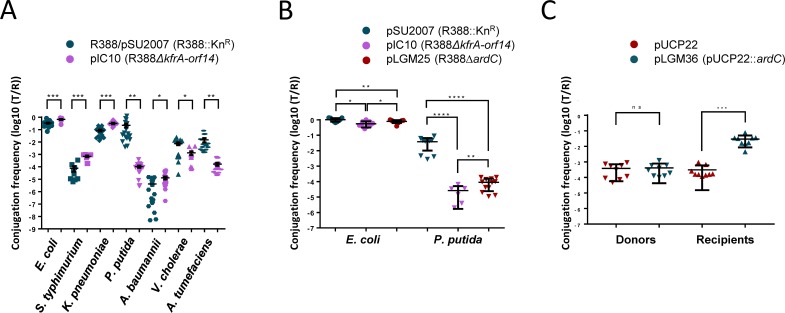Fig 1. ArdC effect in conjugation.
A) Effect of the kfrA-orf14 region on R388 plasmid conjugative transfer from E. coli to different bacteria. Conjugations were performed as described in Materials and Methods at 37 ºC except for P. putida and A. tumefaciens (done at 30 ºC) for 1 h except for A. baumannii and V. cholerae (done for 4 h). R388 was used in conjugations towards E. coli, S. typhimurium and K. pneumoniae. The pSU2007 plasmid was used in conjugations towards the rest of the strains. Donor E. coli BW27783-RifR cells were used as donors in mating experiments with E. coli, S. typhimurium, and K. pneumoniae. Donor E. coli BW27783-NxR cells were employed in matings with the rest of the strains. Conjugation frequencies are shown as transconjugants per recipient (T/R). Horizontal bars represent the mean ± SD of N = 9–20 (Student's t-test: * p < 0.1, ** p < 0.01, *** p < 0.001, **** p <0.0001). B) Effect of ardC and kfrA-orf14 deletions on plasmid conjugative transfer (1 h at 37°C) from E. coli BW27783-NxR to E. coli BW27783-RifR or P. putida KT2440 (N = 6–12). C) Effect in the conjugation frequency of pLGM25 when expressing ardC in donors or recipients. The effect of the presence of plasmid pUCP22 or pUCP22::ardC in donors or recipients is shown. Conjugation was done for 1 h at 37°C with 0.1 mM IPTG in the mating mixture (N = 9).

